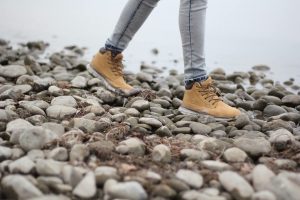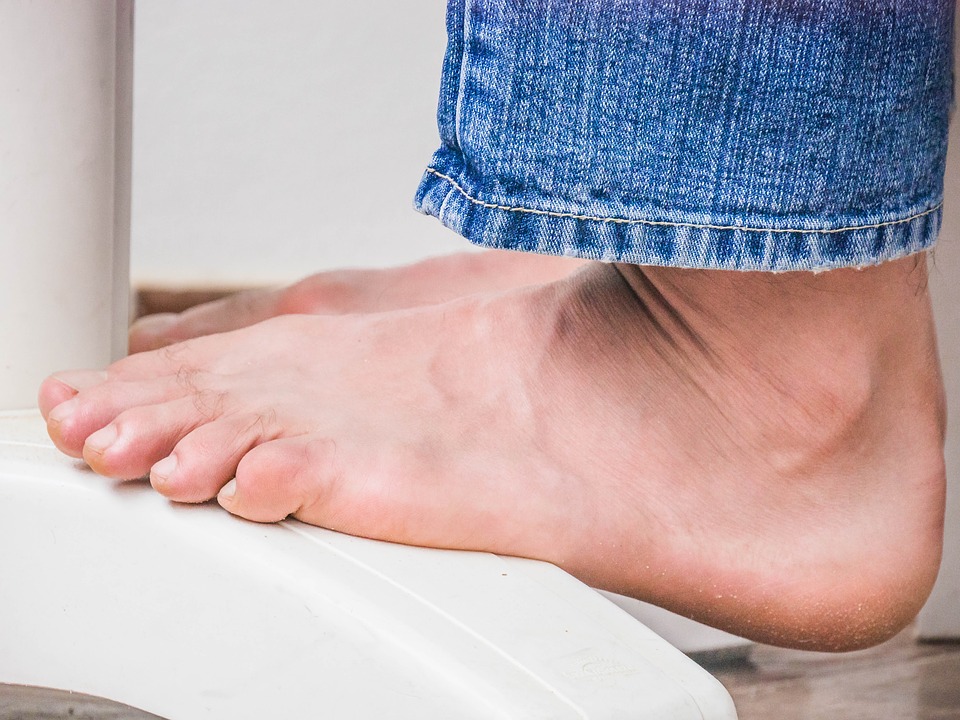The ability to know how our limbs are positioned in space is called proprioception. This ‘sense’ is possible through information gained from individual sensors in the muscles and in the skin. In fact, skin stretch on the back or dorsal surface of the hand has been shown to create illusory movements, indicating that this skin can be used to establish joint position (Collins and Prochazka 1996).
While much research has focused on the upper limb, our recent study (Mildren et al. 2017) looked at the lower limb, and the ankle joint in particular, as accurate movement at the ankle is paramount for successful balance and locomotion. Recent research has highlighted the importance of skin on the top of the foot across the ankle joint (Mildren and Bent 2016), however, substantial skin stretch occurs at the back of the ankle during normal gait and little is known about its contribution to ankle control. Thus, the question we set out to answer was: ‘Does skin at the back of the ankle contribute to the awareness of where the foot is in space’?
At the start of the experiment, we used a servomotor to rotate participants’ left (target) ankle to a pre-determined angle. A test administrator then passively rotated the right (matching) ankle until the participant indicated that the position of the right ankle matched that of the left. During this matching task, participants had their eyes closed, and they also wore headphones. This ensured that they were not using sight or sound to help them estimate the position.
Then, in fourteen participants, we applied a lidocaine anesthetic cream on the skin at the back of the right ankle to remove sensory information from the skin. In another 14 participants, we applied a placebo cream (i.e., unscented skin moisturizer) at the back of the right ankle. After the application of these creams, we then asked both groups of participants to perform the matching task again. We hypothesized that the participants who had lidocaine applied to the back of their right ankles would be less accurate in matching ankle position (i.e., knowing where their right ankles were in space).
WHAT DID WE FIND?
Across all ankle positions tested, participants who had lidocaine cream applied to their right ankles indicated that their feet were aligned when their right foot was in a more dorsiflexed position than their left foot. On average, these participants got worse in matching by 1°. The participants who had the placebo cream applied to the back of their right ankles did not exhibit these errors in matching.
What this means is that, in the participants who received lidocaine, the skin on the back of the ankle had to be stretched to a greater degree (i.e., dorsiflexion, or toes up) for the participants to perceive that their two feet were aligned. We believe this is because increased movement into dorsiflexion was necessary to activate muscle sensors and surrounding intact skin to compensate for the decreased skin input on the posterior ankle, due to the lidocaine anesthetic.
SIGNIFICANCE AND IMPLICATIONS

For the task of ‘touching one’s nose with eyes closed’ – the ability to interpret the position of the elbow joint is critical for success. Likewise, for navigation across a terrain, and over obstacles, the angle of the ankle, and therefore the position of the joint is essential to control – especially when we traverse the ground with as little as 1.3 cm clearance. What we were able to show with this work is that skin on the back of the ankle provides cues of skin stretch that help to decipher ankle position. We know that there is a decline in skin input with natural aging (Wells et al. 2003) and with pathology (Uccioli et al. 1995). From the perspective of future developments and clinical applications, sensory enhancement at the ankle may pay off in reducing associated declines in walking and balance ability for these individuals.
PUBLICATION REFERENCE
Mildren RL, Hare CM, Bent LR. Cutaneous afferent feedback from the posterior ankle contributes to proprioception. Neurosci Lett. 636:145-150, 2017.
If you cannot access the paper, please click here to request a copy.
KEY REFERENCES
Collins DF, Prochazka A. Movement illusions evoked by ensemble cutaneous input from the dorsum of the human hand. J Physiol 496: 857–871, 1996.
Mildren RL, Bent LR. Vibrotactile stimulation of fast-adapting cutaneous afferents from the foot modulates proprioception at the ankle joint. J Appl Physiol 120: 855–864. 2016.
Wells C, Ward LM, Chua R, Inglis JT. Regional variation and changes with ageing in vibrotactile sensitivity in the human footsole. J Gerontol A Biol Sci Med Sci 58: 680–686, 2003.
Uccioli L, Giacomini PG, Monticone G, Magrini A, Durola L, Bruno E, Parisi L, Di Girolamo S, Menzinger G. Body sway in diabetic neuropathy. Diabetes Care. 18: 339–344, 1995.
AUTHOR BIO
 Dr. Leah Bent is an Associate Professor at the University of Guelph. Her research interests lie primarily in understanding the mechanics of skin activation. She uses techniques such as microneurography to record from single cutaneous (skin) nerve fibres in humans to understand how they respond to stretch, vibration and other types of activation. The goal is to understand how activation of different skin sensors contributes to the perception of skin touch and activation of reflex loops for balance control. You can learn more about Dr. Bent’s research here.
Dr. Leah Bent is an Associate Professor at the University of Guelph. Her research interests lie primarily in understanding the mechanics of skin activation. She uses techniques such as microneurography to record from single cutaneous (skin) nerve fibres in humans to understand how they respond to stretch, vibration and other types of activation. The goal is to understand how activation of different skin sensors contributes to the perception of skin touch and activation of reflex loops for balance control. You can learn more about Dr. Bent’s research here.


So, should people with poor balance wear high-topped canvas shoes like Converse?